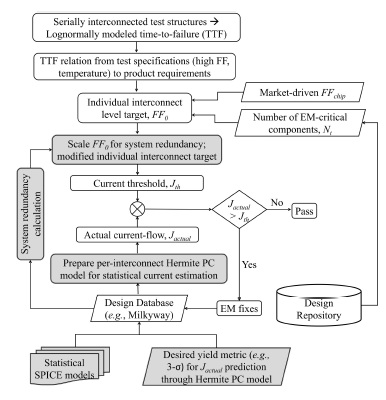- ALL COMPUTER, ELECTRONICS AND MECHANICAL COURSES AVAILABLE…. PROJECT GUIDANCE SINCE 2004. FOR FURTHER DETAILS CALL 9443117328


Projects > ELECTRONICS > 2017 > IEEE > VLSI
A fast and stochastic analysis methodology for electromigration (EM) assessment of power distribution networks is presented in this paper. We examine the impact of variability on EM time-to-failure (TTF), considering altered current densities due to global/local process variations as well as the fundamental factors that cause the conventional EM TTF distribution. Through the novel variations-aware current density model based on Hermite polynomial chaos, we demonstrate significant margins in EM lifetime when compared with the traditional worst case approach. On the other hand, we show that the traditional approach is altogether incompetent in handling transistor-level local variations leading to significantly optimistic lifetime estimates for lower metal level interconnects of power delivery network. Subsequently, we attempt to bridge the conventional, component-level EM verification method to the system level failures, inspired by the extreme order statistics. We make use of asymptotic order models to determine the TTF for the kth component failure due to EM, and demonstrate application of this approach in developing IR drop aware system-level failure criteria.
Inverse (Reciprocal) Gamma Distribution.
A fast and stochastic methodology for EM analysis of power distribution networks has been presented in this paper. The impact of statistical global/local process variation on EM TTF assessment has been examined. Our technical contributions are summarized as follows. We incorporate system redundancy by applying the theory of order statistics and address system failure criteria using an asymptotic failure model to determine the TTF for the kth component failure due to EM. Our approach is cognizant of the typical current-day EDA framework and arrives at a modified component level FF target incorporating a known extent of system redundancy. For a given system, the extent of redundancy is computed one-time as average number of sustainable failures (k) through MC means during the early design phase. As we rely on MC simulation only for one time, it makes our method faster against performing such simulations for every iteration until the PDN optimization is achieved. Thus, our approach efficiently bridges the gap between component and system reliability for a given system. To incorporate the aggravated impact of non-Gaussian statistical process variations under arbitrary workloads, we statistically derive a value for the WC TTF. Our model is based on multivariate Hermite polynomial chaos (PC).
Proposed EM verification flow
